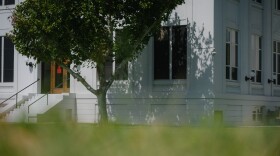ANDREA SEABROOK, host:
As congressional campaigns come down to the wire, candidates and party committees are shoveling money out the door as fast as they can raise it. They're bringing it in too, in stunning amounts. NPR's Peter Overby reports.
PETER OVERBY: To no one's surprise, the third quarter was very, very good to politicians. Collectively, candidates for Congress passed the billion dollar mark. That's according to the Center for Responsive Politics, a nonpartisan group. Another such organization, the Campaign Finance Institute, found that 39 challengers, 30 of them Democrats, had raised more than $1 million a piece. That puts them well over the all-important threshold of viability.
Political scientist Paul Hernson of the University of Maryland explains what the political professionals look for.
Professor PAUL HERNSON (University of Maryland): Once a challenger reaches a certain spinning threshold, they become perceived viable in the campaign communities, in Washington and in their states. And outside groups that support them may be begin to put out direct mail or sponsor television ads.
OVERBY: Ads that most probably will hammer the incumbent, since the challengers can say nice things themselves. Hernson says it's also true that in the money race there's a point of diminishing returns, and Republican incumbents will likely hit it faster than their Democratic challengers will.
Prof. HERNSON: Although incumbents can always spend as much as they need and even more than they need, there are some things that go beyond money.
OVERBY: This year, those would be an incumbent's position on the war in Iraq, economic issues, and now Washington corruption. After a point, more ads won't change voters' perceptions. But no one knows when that point is reached. So both parties are pouring money into House and Senate races, and here, as with the candidates themselves, the Democrats are surprisingly competitive.
Mr. ANTHONY CORRADO (Colby College): You basically have the two parties with $77 million to spend, each, over the last five weeks of the campaign.
OVERBY: Anthony Corrado, with Colby College in Maine, is the author of five books analyzing campaign finance trends.
Mr. CORRADO: You're really going to see twice the level of campaigning that we've seen in the past.
OVERBY: And of course it's already started. Between September 1st and this past Tuesday, the national party committees spent more than $1 million each in Kentucky's Fourth Congressional District. Republican Jeff Davis is trying to fend off Democratic former Congressman Ken Lucas.
And on this past Thursday alone, the Republican National Committee dropped half a million dollars in Tennessee. It bought ads attacking Democratic Senate candidate Harold Ford. Tennessee is pretty much a must win for the GOP. Again, Anthony Corrado...
Mr. CORRADO: There's been so much money spent already by both the candidates and the parties in these swing districts that we're probably reaching a point where more money may not make a lot of difference.
OVERBY: Still, the fundraising machinery keeps grinding away. Money from political action committees is up sharply. Both parties proudly note that more than 40 percent of their money now comes from individuals in donations of less than $200. As for the rest, here's Sheila Krumholz of the Center for Responsive Politics.
Ms. SHEILA KRUMHOLZ (Center for Responsive Politics): Right now the number one source of campaign cash is retired individuals. Now, you know, a valid question is, how is it that these pensioners are able to pack such a punch. But of course many of these are investors, philanthropists, wealthy individuals.
OVERBY: That is, people who not only have a stake in Washington's decisions, but also the wherewithal to catch the attention of the decision makers.
Peter Overby, NPR News, Washington. Transcript provided by NPR, Copyright NPR.






